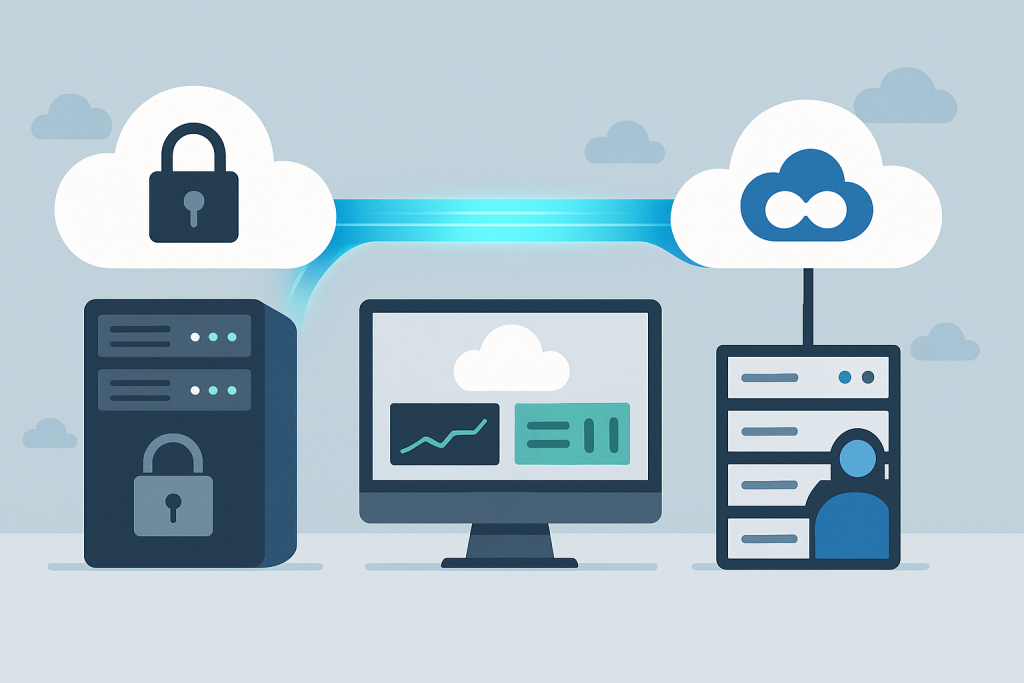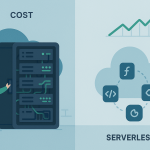In the fast-paced world of technology, businesses are always looking for ways to be more flexible, secure, and cost-effective. For a long time, the debate was simple: stick with your own on-premises servers (like having your own house) or move everything to the Public Cloud (like renting an apartment in a giant complex).
But what if you didn’t have to choose? What if you could have the best parts of both?
Enter Hybrid Cloud Hosting.
This isn’t just a buzzword; it’s the smart, practical, and future-proof way that successful businesses, both big and small, are managing their digital lives today. It’s the ultimate flexible IT solution, allowing you to use a mix of different environments—your own dedicated servers, a Private Cloud, and a Public Cloud—and have them all work together seamlessly as one.
Think of it this way: You have your ultra-secure digital vault (your private environment) for your most sensitive customer data, and you have a massive, expandable warehouse (the public cloud) for all your general web traffic, temporary projects, and big data analysis. Hybrid Cloud is the system that connects the two with a secure, high-speed tunnel, letting your data and applications flow exactly where they need to be.
This comprehensive guide will take a deep dive into exactly what Hybrid Cloud is, why it offers such a huge competitive advantage, and, most importantly, provide a simple, step-by-step roadmap on how you can genuinely implement this powerful strategy for your own business.
Part 1: What Exactly is Hybrid Cloud Hosting?
At its core, Hybrid Cloud Hosting is an IT setup that connects at least one private environment (which could be your company’s on-premises data center or a dedicated Private Cloud run by a hosting expert) with at least one public cloud (like AWS, Google Cloud, or Microsoft Azure).
The crucial part is the integration. These different environments are not just sitting side-by-side; they are interconnected and managed as a single, unified infrastructure. This allows your workloads, data, and applications to move easily and securely between them.
The Three Core Components
To truly understand Hybrid Cloud, you need to know the parts that make up the whole:
1. The Private Cloud (or On-Premises Data Center)
This is your secure, exclusive environment. You have much more control over the hardware, operating system, and network.
- Who uses it? Companies with extremely sensitive data (financial records, patient health information, proprietary formulas) or those with strict regulatory compliance requirements (HIPAA, PCI DSS, GDPR).
- Best for: Stable, predictable workloads, core business applications, and sensitive databases.
2. The Public Cloud
This is the vast, shared infrastructure managed by a third-party provider. Resources are delivered on-demand over the internet, and you pay only for what you use.
- Who uses it? Everyone. It offers near-infinite scalability.
- Best for: Web servers handling high traffic, development and testing environments, temporary or seasonal workloads, and running AI/Machine Learning models that need massive computing power.
3. The Seamless Connection (The “Hybrid” Part)
This is the technology that links the two. It involves secure, high-speed networking solutions (like a Virtual Private Network (VPN) or a dedicated, direct network connection) and unified management tools that let you orchestrate (manage and automate) resources across both environments from a single dashboard. This is the secret sauce that makes the hybrid model genuinely powerful.
Part 2: The Transformative Benefits of Hybrid Cloud
The reason hybrid cloud has become the default strategy for IT modernization is that it doesn’t force a compromise—it offers a way to get the best of all worlds. The benefits touch every part of your business, from your finances to your security to your ability to innovate.
1. Unmatched Flexibility and Agility
The biggest competitive advantage a business can have today is the ability to adapt quickly. Hybrid Cloud delivers this like no other model.
- Cloud Bursting: This is the ultimate flexibility feature. Imagine your private cloud is running at $80\%$ capacity. Then, a major holiday sale or a successful marketing campaign causes a massive, unexpected spike in web traffic. With cloud bursting, the hybrid setup automatically and temporarily shifts the excess workload to the Public Cloud. Once the surge is over, the workload shifts back. You handle the spike flawlessly without over-investing in permanent private infrastructure you’ll rarely use.
- Modernization at Your Own Pace: You don’t have to endure a massive, risky, “rip-and-replace” migration. You can move less critical applications to the Public Cloud first, test the waters, and gradually modernize your core systems over years, not months.
2. Significant Cost Optimization (Not Just Cost Saving)
Cost is a major factor, and Hybrid Cloud allows for strategic spending by optimizing where each dollar goes.
- Capital Expenditure (CapEx) vs. Operating Expenditure (OpEx): Keeping your core systems on a private environment leverages your existing CapEx investment (the hardware you already own). For new, variable, or temporary needs, you leverage the Public Cloud’s OpEx model, paying only for the compute and storage resources you consume on an hourly or minute-by-minute basis.
- Workload Placement: The rule is simple: Stable workloads go on the private environment where the long-term cost-per-unit is often lower. Variable or temporary workloads go on the Public Cloud for maximum pay-as-you-go savings. This intelligent placement ensures you are never paying a high fixed cost for capacity you only need occasionally.
3. Enhanced Security and Compliance Control
This is where the Hybrid Cloud shines brightest, especially for highly regulated industries like healthcare or finance.
- Data Residency and Compliance: Many laws require that sensitive data (like patient or financial records) must physically reside within a specific geography or within a secure, isolated environment. You can use your Private Cloud to meet these strict compliance needs, while using the Public Cloud for non-sensitive data or application front-ends.
- Control over Critical Assets: You retain direct, granular control over your most critical applications and data in the Private Cloud, applying your own, specialized security policies and access controls that go above and beyond the baseline public cloud offerings.
4. Robust Disaster Recovery (DR) and Business Continuity
A hybrid setup turns disaster recovery from a costly headache into an efficient, built-in solution.
- Cost-Effective DR: Instead of maintaining a separate, costly physical disaster recovery site, you can use the Public Cloud as your low-cost backup environment. Your critical private data is constantly replicated to the public cloud, but only minimal compute resources are active. If a disaster strikes, you simply spin up the full application on the public cloud, ensuring minimal downtime and fast recovery.
- Increased Resilience: Having your applications and data distributed across geographically diverse environments (on-premises, private cloud, public cloud) makes your entire IT ecosystem inherently more resilient against local outages.
Part 3: The Step-by-Step Implementation Roadmap
Implementing a Hybrid Cloud isn’t a single project; it’s a strategic, multi-stage journey. Here is a simplified, actionable roadmap to guide your transition.
Step 1: Define Your Business Goals and Assess Workloads
Before you move a single server, you must answer the “Why.” What are you trying to achieve? Cost reduction? Faster time-to-market for new products? Better compliance?
| Objective | Typical Hybrid Cloud Solution |
| Handle Peak Traffic Spikes | Cloud Bursting (Public Cloud) |
| Meet Data Residency Laws | Sensitive data remains in Private Cloud |
| Lower Cost of Disaster Recovery | Use Public Cloud for Backup & Recovery |
| Accelerate App Development | Dev/Test environments on Public Cloud, Production on Private/Public |
The Workload Assessment:
Go through every application and piece of data you have and ask these questions:
- Sensitivity: Is the data highly sensitive or subject to strict regulation? (Private Cloud Priority)
- Variability: Does the demand for this application fluctuate widely? (Public Cloud Priority)
- Performance/Latency: Does it need ultra-low latency access to other core systems? (Private Cloud Priority)
- Legacy: Is it an older system that is difficult to modify? (Keep on-premises or Private Cloud)
This assessment is your blueprint for where every workload will eventually live.
Step 2: Design the Hybrid Architecture and Choose Providers
The architecture is the how—the design of the secure tunnel and the management layer that connects your environments.
- Establish the Connectivity: You need a secure, dedicated network link. A VPN (Virtual Private Network) is the minimum requirement for encrypted data transfer, but for high-volume, mission-critical systems, you should consider a Direct Connect solution offered by cloud providers (e.g., AWS Direct Connect, Azure ExpressRoute). This bypasses the public internet for better speed and reliability.
- Select Your Public Cloud Partner: Don’t assume you must use one provider. Choose the Public Cloud (or Clouds—a Multi-Cloud Hybrid approach) whose services, geographic regions, and pricing models best align with your workload needs.
- Standardize the Management Layer: This is perhaps the most critical technical step. You need unified tools that let you manage and monitor all your resources (servers, storage, network) from one single view, regardless of whether they are private or public. Tools for orchestration (like Kubernetes for containers) and unified monitoring are essential to prevent the hybrid environment from becoming a complex, fragmented mess.
Step 3: Implement Security, Governance, and Compliance
The moment you connect two environments, you create a new security perimeter. You must apply a consistent security model.
- Zero-Trust Security: Adopt a “Never Trust, Always Verify” policy. This means that every user, device, and application attempting to access a resource—whether it’s in the private or public cloud—must be verified. Security policies must be consistent across the entire hybrid environment.
- Centralized Identity and Access Management (IAM): Your employees shouldn’t need a separate login for the private cloud and the public cloud. Implement a single, unified IAM system to control who can access what resources across all environments.
- Compliance-as-Code: Use automated tools to ensure compliance rules (like data encryption standards or logging requirements) are automatically applied every time a new resource is deployed, regardless of the environment.
Step 4: Execute the Migration
With your blueprint and architecture in place, you begin the migration, which should be done in phases.
- Start with Dev/Test: These are the lowest-risk workloads. Move your development and testing environments to the Public Cloud first. This lets your teams learn the tools and processes without impacting live operations.
- Move Non-Critical Apps: Next, migrate simple, less-sensitive applications using a “lift-and-shift” approach (moving the application as-is).
- Address Core Workloads: For your complex, core business applications, you may need a “re-platforming” or “re-architecting” approach to fully benefit from cloud-native features. This is a longer, more involved process that should only happen after you have proven the success of the first phases.
- Implement Disaster Recovery: Test and formalize your Public Cloud DR solution, ensuring that the failover and failback procedures work perfectly.
Step 5: Monitor, Optimize, and Refine (Ongoing)
Hybrid Cloud is a living ecosystem. You are never truly “done.”
- Financial Operations (FinOps): Because you are using a variable cost model in the public cloud, constant cost monitoring is vital. Set up alerts for unexpected usage, track usage trends, and regularly review your workload placements. The goal is to continuously ensure every workload is on the most cost-effective platform.
- Performance Monitoring: Use your unified management tools to monitor latency, uptime, and resource utilization across the entire hybrid environment.
- Iterate and Automate: Look for opportunities to introduce more automation. Can you automate the scaling of a public cloud resource? Can you automate compliance checks? The more you automate, the more efficient your hybrid cloud will become.
Conclusion: The Future is Seamless
Hybrid Cloud Hosting is not just a technology choice; it’s a business strategy. It acknowledges the reality that no single environment is perfect for every single workload. By cleverly combining the control and security of a private environment with the scalability and cost-efficiency of the public cloud, you build a resilient, agile, and cost-optimized IT foundation ready for whatever the future holds.
It is the path to digital transformation that allows you to move forward without abandoning the investments that still serve your business well. The goal is a seamless experience for your customers and a simplified, powerful foundation for your IT team. Embrace the blend, and unlock the full potential of your digital infrastructure.



